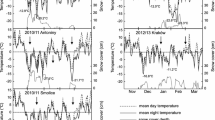Summary
Using a fine thermojunction, the freezing points of both of the living tissue and the dead one of Buxus leaves were observed by repeating the treatment of freezing and thawing. The seasonal change in the water content was also observed in parallel with those. Moreover, the process of ice formation in freezing was observed macroscopically and microscopically.
Principal results are as follows:
-
1.
The double freezing, which had been frequently observed in storage tissues, was shown markedly in a freezing curve. The double freezing may be a discontinuous phenomenon between the extracellular and the intracellular freezing.
-
2.
In the formation of “Frostblase”, the ice was formed on the outside of the cells beneath the veins which may have hight water permeability and grew gradually by obtaining the water from these cells. When the ice piece grew larger, the spongy tissue was easily separated from the stiff layer of veins developing just beneath the palisade tissue.
-
3.
The water, participating in an ice formation, was supplied in a considerable amount through a petiole besides the water involved in the leaf itself.
-
4.
Even when a leaf was frozen under field conditions, the ice located as “Frostblase” on a distinct part of the leaf, and the intracellular space did not freeze. Therefore, there was no damage.
-
5.
In winter, the freezing point of living tissue depended on the solute rather than on the colloidally bound water and was considerably lower than the air temperature.
-
6.
In spring, the freezing point of younger or older leaves became considerably high and the freezing of leaves was induced often when the air temperature dropped suddenly. It seems that in Buxus the leaves are adapted to cold temperature because even when the leaves are frozen they form the “Frostblase” and do not suffer any damage.
Similar content being viewed by others
References
Hatakeyama, I.: An example of double freezing of a green leaf. Kagaku (Tokyo) 22, 652–653 (1952) [in Japanese].
Hatakeyama, I.: The relation between growth and cold hardiness of leaves of Camellia sinensis. Biol. J. Nara Women's Univ. No 10, 65–69 (1960) [in Japanese, with English summary].
—: Studies on the freezing of living and dead tissues of plants, with special reference to the colloidally bound water in living state. Mem. Coll. Sci. Univ. Kyoto B 28, 401–429 (1961).
Kawano, K., and I. Hatakeyama: Studies on the solute of the cell sap of mulberry trees. (1) Seasonal changes in the solute ratio of the expressed sap of leaves. Bull. Fac. Text. Fib. Kyoto Univ. of Industry Arts and Textile Fibers 3, 217–220 (1961).
—, R. Tuzii, and I. Hatakeyama: Studies on the seasonal change in the freezing point of the bud of mulberry tree. Bull. Fac. Text. Fib. Kyoto Univ. of Industry Arts and Textile Fibers 3, 32–36 (1960).
———: Seasonal changes in the osmotic value, water content and solute ratio of the bud of mulberry tree. Bot. Mag. (Tokyo) 74, 118–121 (1961).
Maximov, N. A.: Experimentelle und kritische Untersuchungen über das Gefrieren und Erfrieren der Pflanzen. Jb. wiss. Bot. 53, 327–420 (1914).
Molisch, H.: Pflanzenbiologie in Japan, S. 222. Über die Lage der Blätter bei Aucuba und Litsea im Winter. Jena (1926).
Sakamura, T.: Plant physiology, p. 131. Freezing in cells and tissues. Tokyo (1950). [In Japanese].
Scarth, G. W., and J. Levitt: The frost-hardening mechanism of plant cells. Plant Physiol. 12, 51–78 (1937).
Siminovitch, D., and G. W. Scarth: A study of the mechanism of frost injury to plants. Canad. J. Res. C 16, 467–481 (1938).
Steiner, M.: Zum Chemismus der osmotischen Jahresschwankungen einiger immergrüner Holzgewächse. Jb. wiss. Bot. 78, 564–622 (1933).
Author information
Authors and Affiliations
Additional information
Contribution NO. 1 from the Laboratory for Plant Ecological Studies.
Rights and permissions
About this article
Cite this article
Hatakeyama, I., Kato, J. Studies on the water relation of Buxus leaves. Planta 65, 259–268 (1965). https://doi.org/10.1007/BF00390127
Received:
Issue Date:
DOI: https://doi.org/10.1007/BF00390127




